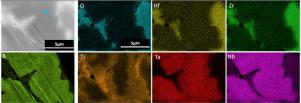当前位置:
X-MOL 学术
›
Acta Mater.
›
论文详情
Our official English website, www.x-mol.net, welcomes your feedback! (Note: you will need to create a separate account there.)
Part II: Experimental Verification of Computationally Predicted Preferential Oxidation in Refractory High Entropy Ultra-high Temperature Ceramics
Acta Materialia ( IF 9.4 ) Pub Date : 2020-09-01 , DOI: 10.1016/j.actamat.2020.07.004 Lavina Backman , Joshua Gild , Jian Luo , Elizabeth J. Opila
Acta Materialia ( IF 9.4 ) Pub Date : 2020-09-01 , DOI: 10.1016/j.actamat.2020.07.004 Lavina Backman , Joshua Gild , Jian Luo , Elizabeth J. Opila

|
Abstract Refractory high entropy materials have garnered significant research interest due to their potential ability to fill a need in high temperature structural applications. However, challenges remain with respect to designing for oxidation resistance. A knowledge gap exists with respect to a rigorous understanding of the mechanisms driving oxidation processes unique to high entropy materials. This work provides an experimental complement to a companion publication, which outlines analytical and computational thermodynamic approaches that are envisioned to aid the design of refractory high entropy materials containing group IV (Hf, Zr, Ti) and group V (Ta, Nb) constituents. In this work, (Hf0.2Zr0.2Ti0.2Ta0.2Nb0.2) carbide and diboride specimens were exposed at 1700°C in 1% O2 for 5 min. Experimental results show good agreement with the computational predictions for the same temperature, despite differences in the overall morphology of the oxidized regions. The carbide formed porous oxides, while the diboride formed a denser external scale. Oxidation products are dominated by group IV oxides, depleting the underlying materials, which were found to consist of primarily group V carbides and borides respectively. The results provide a first look at the oxidation of high entropy UHTCs at ultra-high temperatures and validate the preferential nature of high entropy material oxidation predicted by the computational approach developed for the study of this new class of materials.
中文翻译:

第二部分:耐火高熵超高温陶瓷中计算预测优先氧化的实验验证
摘要 耐火高熵材料由于其潜在的满足高温结构应用需求的能力而引起了广泛的研究兴趣。然而,在设计抗氧化性方面仍然存在挑战。在严格理解驱动高熵材料独有的氧化过程的机制方面存在知识差距。这项工作为配套出版物提供了实验补充,该出版物概述了分析和计算热力学方法,旨在帮助设计包含 IV 族(Hf、Zr、Ti)和 V 族(Ta、Nb)成分的耐火高熵材料。在这项工作中,(Hf0.2Zr0.2Ti0.2Ta0.2Nb0.2) 碳化物和二硼化物样品在 1% O2 中于 1700°C 下暴露 5 分钟。尽管氧化区域的整体形态存在差异,但实验结果与相同温度的计算预测非常吻合。碳化物形成多孔氧化物,而二硼化物形成更致密的外部氧化皮。氧化产物以 IV 族氧化物为主,消耗了下面的材料,发现它们分别主要由 V 族碳化物和硼化物组成。该结果首次展示了高熵 UHTC 在超高温下的氧化,并验证了为研究此类新型材料而开发的计算方法所预测的高熵材料氧化的优先性质。而二硼化物形成更致密的外部水垢。氧化产物以 IV 族氧化物为主,消耗了下面的材料,发现它们分别主要由 V 族碳化物和硼化物组成。该结果首次展示了高熵 UHTC 在超高温下的氧化,并验证了为研究此类新型材料而开发的计算方法所预测的高熵材料氧化的优先性质。而二硼化物形成了更致密的外部水垢。氧化产物以 IV 族氧化物为主,消耗了下面的材料,发现它们分别主要由 V 族碳化物和硼化物组成。该结果首次展示了高熵 UHTC 在超高温下的氧化,并验证了为研究此类新型材料而开发的计算方法所预测的高熵材料氧化的优先性质。
更新日期:2020-09-01
中文翻译:

第二部分:耐火高熵超高温陶瓷中计算预测优先氧化的实验验证
摘要 耐火高熵材料由于其潜在的满足高温结构应用需求的能力而引起了广泛的研究兴趣。然而,在设计抗氧化性方面仍然存在挑战。在严格理解驱动高熵材料独有的氧化过程的机制方面存在知识差距。这项工作为配套出版物提供了实验补充,该出版物概述了分析和计算热力学方法,旨在帮助设计包含 IV 族(Hf、Zr、Ti)和 V 族(Ta、Nb)成分的耐火高熵材料。在这项工作中,(Hf0.2Zr0.2Ti0.2Ta0.2Nb0.2) 碳化物和二硼化物样品在 1% O2 中于 1700°C 下暴露 5 分钟。尽管氧化区域的整体形态存在差异,但实验结果与相同温度的计算预测非常吻合。碳化物形成多孔氧化物,而二硼化物形成更致密的外部氧化皮。氧化产物以 IV 族氧化物为主,消耗了下面的材料,发现它们分别主要由 V 族碳化物和硼化物组成。该结果首次展示了高熵 UHTC 在超高温下的氧化,并验证了为研究此类新型材料而开发的计算方法所预测的高熵材料氧化的优先性质。而二硼化物形成更致密的外部水垢。氧化产物以 IV 族氧化物为主,消耗了下面的材料,发现它们分别主要由 V 族碳化物和硼化物组成。该结果首次展示了高熵 UHTC 在超高温下的氧化,并验证了为研究此类新型材料而开发的计算方法所预测的高熵材料氧化的优先性质。而二硼化物形成了更致密的外部水垢。氧化产物以 IV 族氧化物为主,消耗了下面的材料,发现它们分别主要由 V 族碳化物和硼化物组成。该结果首次展示了高熵 UHTC 在超高温下的氧化,并验证了为研究此类新型材料而开发的计算方法所预测的高熵材料氧化的优先性质。



























 京公网安备 11010802027423号
京公网安备 11010802027423号